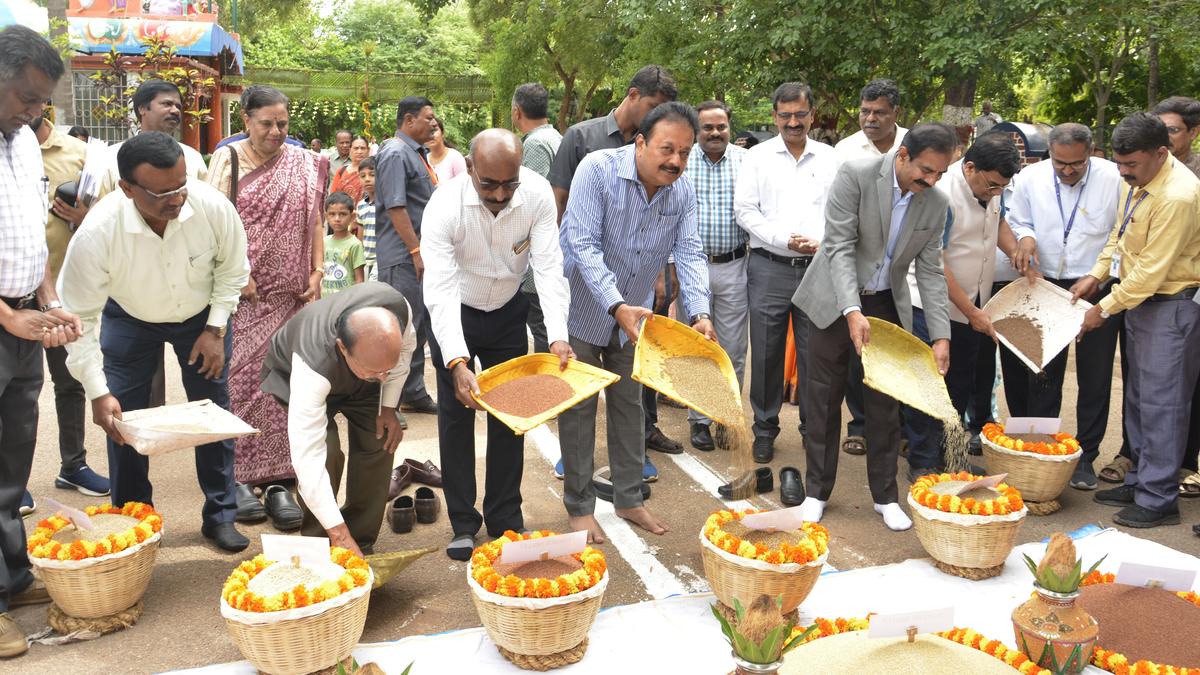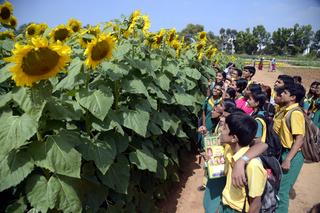Agriculture experts in Karnataka have raised a strong demand for reforming the current higher education model by merging the existing specialized agriculture and allied universities into integrated institutions. Presently, the state has separate universities for agriculture, veterinary sciences, horticulture, and fisheries, each focusing on its confined domain. Experts argue that this fragmented approach creates limitations in research collaboration, resource utilization, and curriculum diversity. They believe that unifying these institutions into integrated universities will help students gain multidisciplinary exposure, strengthen innovation, and prepare them for modern challenges in agriculture and allied sectors.
Karnataka, known for its agricultural diversity, has been facing numerous challenges ranging from climate change and soil degradation to fluctuating markets and resource constraints. Experts point out that addressing these issues requires comprehensive research cutting across horticulture, animal husbandry, fisheries, biotechnology, and environmental sciences. Isolated universities, they argue, prevent knowledge sharing and reduce efficiency, as each institution functions independently with its own administrative and financial structures. By moving to integrated models, experts say, the state can create centres of excellence that foster inter-disciplinary learning, reduce duplication of resources, and accelerate problem-solving for farmers’ needs.
Students and faculty have also echoed the call for integration, highlighting how exposure to allied fields can improve career prospects and practical learning. For instance, an agriculture student familiar with veterinary or fisheries sciences will have better understanding of farming systems as a whole. Integrated universities can provide holistic education, ensuring that graduates are equipped with cross-sectoral skills. Moreover, combining research facilities under one umbrella can make Karnataka a hub for agricultural innovation, enabling the state to compete nationally and globally in terms of sustainable practices and productivity solutions.
Why Integration Matters for the Future of Agriculture
Agriculture experts stress that the farming sector no longer functions in silos, and academic institutions must reflect that reality. For example, climate-resilient agriculture demands integration of soil science, crop science, hydrology, and animal management. Similarly, value-addition industries in food processing require knowledge across horticulture, dairy, and fisheries. The current segregated system limits such cross-pollination of knowledge. Integration, they argue, would enable students to think systemically rather than narrowly, producing professionals capable of handling complex agricultural ecosystems. This approach is particularly urgent in the face of unpredictable weather and rising farmer distress across Karnataka.
Faculty members argue that resource pooling would also allow for better use of infrastructure and funding. Currently, separate universities often duplicate efforts by maintaining similar research labs and administrative structures, stretching limited budgets thin. By unifying them, experts believe resources can be concentrated in state-of-the-art laboratories, extension centres, and digital learning platforms that serve a larger community of students and farmers. Such structural reforms would also help attract more central government funding and international collaborations, which increasingly favor integrated research models over isolated ones.
Experts in Karnataka argue that agriculture is evolving beyond traditional boundaries, demanding a more unified approach to education and research. The current fragmented structure of agricultural universities creates barriers to innovation, as each institution operates within its own silo. By integrating them, the state can encourage interdisciplinary collaboration that mirrors the interconnectedness of farming systems in reality. For example, crop production is influenced by animal health, soil quality, and water conservation, all of which require expertise across different allied sciences. This holistic model would prepare students to address multifaceted challenges in modern agriculture more effectively.

Farmers stand to benefit directly from such integration. Presently, extension services from universities often provide partial solutions, focusing only on crop cultivation or livestock without considering the broader farming ecosystem. Integrated universities could streamline outreach efforts, offering farmers comprehensive advice that combines crop management, animal husbandry, fisheries, and post-harvest technologies. Experts believe this will enhance farm productivity, improve profitability, and reduce the knowledge gap between farmers and research institutions. The shift would also ensure that innovations in one sector, such as livestock nutrition, are not isolated from related advancements in crop residue management.
Research output, too, is expected to grow under integrated models. Currently, many projects remain limited in scope due to the lack of collaboration across disciplines. For instance, soil scientists may not always coordinate with veterinary experts or fisheries researchers, missing opportunities for synergy. By bringing diverse faculties under one umbrella, Karnataka could foster groundbreaking solutions like integrated farming systems, climate-resilient crop-livestock models, and water-efficient aquaculture practices. Such advances are vital to sustain the state’s agricultural economy in the face of climate uncertainty.
Students have consistently voiced concerns about limited exposure to interdisciplinary knowledge under the present system. Many feel restricted by the narrow scope of their courses, which hinders them from exploring broader opportunities in the agriculture sector. With integrated universities, they could pursue cross-disciplinary studies, gaining skills in areas such as agribusiness, biotechnology, and environmental sustainability alongside traditional agricultural sciences. This would significantly enhance their employability, enabling them to work in diverse roles across research, corporate agribusiness, and government policy-making.
The state’s agricultural universities have been facing criticism for lagging behind in adopting modern teaching practices and industry linkages. Integration could provide a fresh start, enabling the adoption of updated curricula, digital learning tools, and international partnerships. Experts argue that collaborative programs with global universities are easier to secure when institutions present themselves as comprehensive centres of excellence. Karnataka, with its diverse agricultural base, has the potential to position itself as a leader in integrated agricultural research, attracting global talent and investments in food and farming innovations.
A Call for Policy Intervention
Experts have urged the Karnataka government to take immediate steps toward restructuring agricultural higher education. They recommend the formation of a high-level committee to study integration models in states like Tamil Nadu and Maharashtra, where similar approaches have been tested. They also stress that integration should be carried out thoughtfully, ensuring that specialized expertise is preserved while enabling collaboration across disciplines. Without such reforms, they warn, Karnataka risks falling behind in agricultural innovation, leaving farmers without the comprehensive solutions they desperately need. Integration, they believe, is not just an academic restructuring—it is a long-term investment in the state’s agricultural future.
Critics of the current system highlight inefficiencies in administrative spending. Maintaining separate universities requires duplicating expenses on staff, buildings, and governance structures. By merging them into fewer integrated institutions, these costs can be reduced, and funds can be redirected to student support, farmer outreach, and advanced research. This restructuring would also make it easier for the state government to monitor and regulate quality standards in agricultural education, ensuring uniformity and accountability across campuses.

Another significant advantage of integration is the potential for policy-oriented research. Complex agricultural problems often require inputs from multiple disciplines, including economics, social sciences, and environmental studies. Integrated universities can bring together expertise from diverse fields, producing data-driven solutions for government policy. For instance, tackling farmer indebtedness may involve agronomy, market analysis, and rural sociology, all of which can be addressed more effectively in a unified institutional framework. This would strengthen Karnataka’s ability to design farmer-friendly policies that are both practical and sustainable.
The global agricultural landscape is moving toward interdisciplinary approaches, and Karnataka risks being left behind if it continues with fragmented institutions. Countries with integrated agricultural universities, such as the United States and the Netherlands, have made remarkable progress in sustainable farming and agri-innovation. Experts insist that Karnataka must learn from these models and adapt quickly, especially as climate change threatens the state’s agricultural productivity. By adopting an integrated framework, Karnataka could position itself as a global knowledge hub in agriculture and allied sciences.
Some stakeholders, however, caution that integration should not dilute the depth of expertise in specific disciplines. They emphasize that while universities must work together, specialized faculties like fisheries or veterinary sciences should retain their focus and identity. Integration, they argue, should be about collaboration rather than homogenization. Experts suggest creating common governing councils and shared research facilities, while maintaining specialized schools within the integrated universities. This would balance the need for depth with the benefits of interdisciplinarity.
Ultimately, the call for integration reflects a broader shift in how society views agriculture. Farming is no longer seen as merely crop cultivation but as a complex, interlinked system involving livestock, water, markets, and technology. Karnataka’s agricultural universities must evolve accordingly, experts argue. Integration represents an opportunity to modernize, improve efficiency, and build a stronger connection between research and farmer welfare. If implemented with care, this reform could become a turning point in the state’s agricultural education and development, ensuring resilience and growth for decades to come.
Follow: Karnataka Government
Also read: Home | Channel 6 Network – Latest News, Breaking Updates: Politics, Business, Tech & More

